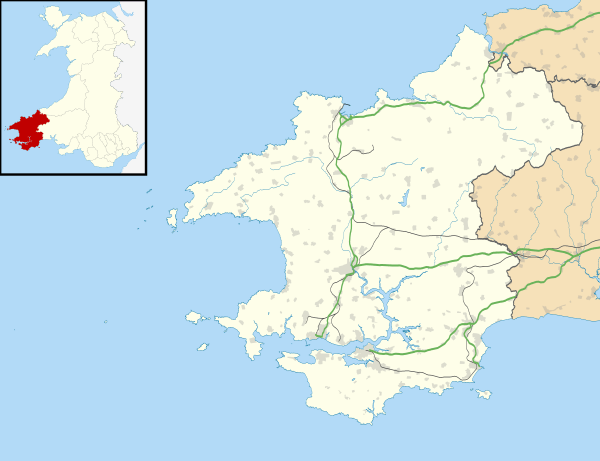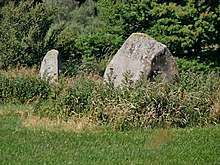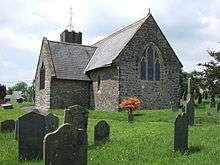Maenclochog
Maenclochog (![]()
![]()
Maenclochog
| |
|---|---|
 Maenclochog Location within Pembrokeshire | |
| Population | 731 (2011)[1] |
| OS grid reference | SN0834127337 |
| Principal area | |
| Ceremonial county | |
| Country | Wales |
| Sovereign state | United Kingdom |
| Post town | MAENCLOCHOG |
| Postcode district | SA66 |
| Dialling code | 01437 |
| Police | Dyfed-Powys |
| Fire | Mid and West Wales |
| Ambulance | Welsh |
| UK Parliament | |
The Maenclochog community population was 731 in 2011.
Maenclochog lies south of the Preseli Hills, about one mile southeast of Rosebush on the B4313 Narberth to Fishguard road.
Origin of the name
The origin of the name Maenclochog is unclear. It appears to be made up of two Welsh words, maen ("stone") and clochog ("noisy, clamorous").[2][3] A local tale reports that there were stones near Ffynnon Fair ("Mary's Well"), to the south of the village, which rang like bells when struck, but these were blown up by treasure-hunters, in the mistaken belief that they concealed a golden treasure. This may represent nothing more than folk etymology. An alternative proposal is that the second part of the name comes from the Irish word, clochog, meaning a craggy place. This theory is supported by the fact that there was Irish migration to Pembrokeshire in the early Middle Ages, as attested to by the 5th or 6th century Ogham stones found in the locality and elsewhere, and certainly the name suits the topography of the area.[4][5]
History

_NLW3363834.jpg)
There is evidence of prehistoric occupation in the vicinity of the present village.[6]
Researchers have found what are believed to be the remains of a 13th-century castle at Maenclochog.[7] Maenclochog (as Mancloghay) appears on a 1583 parish map of Pembrokeshire.[8]
The village was served by the Maenclochog Railway, formally known as the Narberth Road and Maenclochog Railway, which ran from Clynderwyn on the Great Western Railway via Maenclochog to Rosebush. The tunnel just outside Maenclochog was used during World War 2 as a bomb-test site for Barnes Wallis, creator of the bouncing bomb.[9]
Following the Second World War an attempt by the War Office to take over 16,000 acres of the Preselau slopes, as a permanent military training ground, was thwarted by a strong campaign led by local ministers of religion and headteachers. The acquisition would have meant a loss of farming livelihood, and Maenclochog might have become a garrison village.[10]
Community

The village has a local committee to discuss village affairs. There are two general stores and two petrol stations with an MOT service. In the centre of the village is St Mary's church (Welsh: Eglwys Fair), the park and the green on a small road island. In the village there are many businesses that include two electrical wholesalers and an art gallery. There is a school and a carpenter's situated about 50 metres northwest of the church. Opposite the green is a pub, The Globe.[11]
Education
Ysgol Gymunedol Maenclochog[12] is a Welsh-medium primary school built in 1878; it has roughly 100 pupils ranging from age 3 to 11.
Between Maenclochog and Llanycefn is Nant-y-Cwm School, an independent, co-educational Steiner Waldorf school,[13][14] taking pupils from ages 3 to 14. It was founded in 1979 in a converted Victorian building that was originally the village school for Llanycefn,[15] a Board School that ran from 1877 to 1964.[16] The original school records are available to view at the Pembrokeshire Records Office in Haverfordwest.[17]
Anglican Church
In the centre of the village green is the Anglican (Church in Wales) church of St Mary, of mediaeval origins but substantially restored in the 19th century. The architecture was fully described when the church was Grade II listed in 1971.[5][18]
References
- "Community population 2011". Retrieved 20 April 2015.
- Y Geiriadur Mawr, Gwasg Gomer
- Geiriadur Prifysgol Cymru
- Naws am Le/Sense of Place: PLANED leaflet 2010
- Cadw. "Church of St Mary (Grade II) (6078)". National Historic Assets of Wales. Retrieved 26 July 2019.
- "Dyfed Archaeological Trust". Retrieved 24 March 2015.
- "Castle wall find at car park dig". bbc.co.uk. 25 September 2007. Retrieved 28 September 2007.
- "Penbrok comitat". British Library.
- "Castle (Maenclochog) Tunnel".
- Wyn, Hefin (2008). Battle of the Preselau. ISBN 978-0-9549931-3-9.(editions in Welsh and English)
- "Pembrokeshire County Council: Visit Pembrokeshire". Retrieved 24 March 2015.
- "Ysgol Gymunedol Maenclochog". Archived from the original on 24 December 2012. Retrieved 24 March 2015.
- "State funds call for new school". BBC News. 12 September 2005. Retrieved 8 March 2018.
- "Steiner Waldorf to open second school in Wales". Wales Online. 22 March 2013. Retrieved 8 March 2018.
- http://www.estyn.gov.uk/download/publication/92956.5/inspection-reportnant-y-cwm-schooleng2008/
- Archives Network Wales - Primary School Records
- "Pembrokeshire County Council Records: Llanycefn Board School". Retrieved 8 March 2018.
- "British Listed Buildings". Retrieved 26 March 2015.
External links
| Wikimedia Commons has media related to Maenclochog. |
